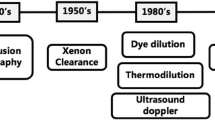Abstract
Isometric and isotonic endurance levels of both elbow flexors and knee extensors were tested during inspired gas mixtures of ca. 10%, 21% or 100% oxygen in nitrogen. The four work loads were set a 25, 50, 60 and 70% of maximal volitional isometric strength (IS). The isotonic exercise routine was carried out using weight lifting techniques of 20 repetitions per min from 75° to 105° of elbow flexion and knee extension respectively. Prior to, during, and after the endurance experiments133Xe clearance was monitored by light weight scintillation counters. A depot of 0.1 to 0.2 ml of isotonic saline containing 50 to 150 μCi of the isotope was used as an intramuscular tracer. The exercise clearance values varied inversely to the test load during isometric exercise. Isotonic exercise for both elbow flexors and knee extensors showed increasing clearance values up to 60% IS. Above this level a decrease in total clearance was recorded. Oxygen tension had no statistical effect on the clearance values. However, the relatively large scatter of the133Xe clearance method, and an inhomogenous perfusion of skeletal muscle may have masked any anticipated effect of the various O2 tensions. Variations due to the raised intramuscular pressure appeared to be much more dominant than the hypothezised variation due to the 3 set oxygen tensions.
Similar content being viewed by others
References
Avouac, B., Delavalle, F., Lemaire, C., Monod, H.: Absence d'ffets des variations de la pression partielle de l'xygène de l'air inspiré sur la capacité de travail musculaire local. IX Congr. Soc. Ergonom. Lang. Franc, Paris (1972)
Bolme, P., Edwall, L.: Dissociation of tracer disappearance rate and blood flow in isolated skeletal muscle during various vascular reactions. Acta physiol. scand.82, 17–27 (1971)
Bonde-Petersen, F.: Muscle training by static, concentric and eccentric contractions. Acta physiol. scand.48, 406–416 (1960)
Bonde-Petersen, F.: Physical performance capacity in patients with dysbasia arteriosclerotica. I. Evaluation by bycicle ergometry at varying work loads. Scand. J. Rehab. Med.6, 19–25 (1974)
Bonde-Petersen, F., Henriksson, J., Lundin, B.: Blood flow in thigh muscle during bicycling exercise at varying work rates. Europ. J. appl. Physiol.34, 191–197 (1975)
Bonde-Petersen, F., Mørk, A. L., Nielsen, E.: Local muscle blood flow and sustained contractions of human arm and back muscles. Europ. J. appl. Physiol.34, 43–50 (1974)
Bonde-Petersen, F., Siggaard-Andersen, J.: Simultaneous venous occlusion plethysmography and133Xe clearance in patients with arteriosclerosis of the lower extremities. An attempt to evaluate the blood flow in skin and muscle. Scand. thorac. cardiovasc. Surg.3, 20–25 (1969)
Bonde-Petersen, F., Vestergaard-Christensen, L.: Blood flow in human temporal muscle during tooth grinding and clenching as measured by133Xenon clearance. Scand. J. dent. Res.81, 272–275 (1973)
Christensen, E. H., Nielsen, H. E.: Die Leistungsfähigkeit der menschlichen Skelettmuskel bei niedrigem Sauerstoffdruck. Skand. Arch. Physiol.74, 272–280 (1936)
Clausen, J. P., Lassen, N. A.: Muscle blood flow during exercise in normal man studied by133Xenon clearance method. Cardiovasc. Res.5, 245–254 (1971)
Conn, H. L.: Equilibrium distribution of radio-Xenon in tissue: Xenon-hemoglobin association curve. J. appl. Physiol.16, 1065–1070 (1961)
Darcus, H. D.: The maximum torques developed in pronation and supination of the right hand. J. Anat. (Lond.)85, 55–57 (1951)
Fagraeus, L., Karlsson, J., Linnarson, D., Saltin, B.: Oxygen uptake during maximal work at lowered and raised ambient air pressure. Acta physiol. scand.87, 411–421 (1973)
Grimby, G., Häggendal, E., Saltin, B.: Local xenon 133 clearance form the quadriceps muscle during exercise in man. J. appl. Physiol.22, 305–310 (1967)
Grosse-Lordemann, H., Müller, E. A.: Der Einfluß der Leistung und der Arbeitsgeschwindigkeit an das Arbeitsmaximum und den Wirkungsgrad beim Radfahren. Int. Z. angew. Physiol.2, 454–475 (1937)
Hansen, M., Madsen, J.: Estimation of relative changes in resting muscle blood flow by133Xe washout: The effect of oxygen. Scand. J. clin. Lab. Invest.31, 133–139 (1973)
Hirzel, H. O., Krayenbuehl, H. P.: Validity of the133Xenon method for measuring coronary blood flow. Comparison with coronary sinus outflow determined by an electromagnetic flowprobe. Pflügers Arch.349, 159–169 (1974)
Holzman, G. B., Wagner, H. N., Iio, M., Rabinowitz, D., Zierler, K. L.: Measurement of muscle blood flow in the human forearm with radioactive Krypton and Xenon. Circulation30, 27–34 (1974)
Kaijser, L.: Limiting factors for aerobic muscle performance. The influence of varying oxygen pressure and temperature. Acta physiol. scand.346 (Suppl.), 1–96 (1970)
Kety, S. S.: Measurement of regional circulation by the local clearance of radioactive sodium. Amer. Heart J.38, 322–328 (1949)
Lassen, N. A., Lindbjerg, I. F., Munck, O.: Measurement of blood flow through skeletal muscle by intramuscular injection of133Xe. Lancet1964 I, 686–689
Margaria, R.: Die Arbeitsfähigkeit des Menschen bei vermindertem Luftdruck. Arbeitsphysiologie2, 261–272 (1929)
Monod, H.: Contribution a l'étude du travail statique. Thèse Méd., p. 121, Paris (1956)
Samson, M.: Contribution a l'étude ergométrique de la fatigue neuromusculaire normale et pathologique. Thèse pour le doctorat en médecine. Paris: Foulon 1953
Scherrer, J., Monod, H.: Le travail musculaire local et la fatigue chez l'homme. J. Physiol. (Paris)52, 419–501 (1960)
Siggaard-Andersen, J., Bonde-Petersen, F.: Venous occlusion plethysmography and133Xe clearance measured simultaneously on the calf in normal subjects. Scand. J. clin. Lab. Invest.19, 106–112 (1967)
Tornvall, G.: Assessment of physical capabilities. With special reference to evaluation of maximal voluntary isometric muscle strength and maximal working capacity. An experimental study on civilian and military subject groups. Acta physiol. scand.201 (Suppl.), 1–102 (1963)
Vogel, J. A., Pulver, R. I., Burton, T. M.: Regional blood flow distribution during simulated high-altitude exposure. Fed. Proc.28, 1155–1159 (1969)
Author information
Authors and Affiliations
Rights and permissions
About this article
Cite this article
Hermiston, R.T., Bonde-Petersen, F. The influence of varying oxygen tensions in inspired gas on133Xenon muscle clearance and fatigue levels during sustained and dynamic conctractions. Europ. J. Appl. Physiol. 34, 291–302 (1975). https://doi.org/10.1007/BF00999942
Received:
Issue Date:
DOI: https://doi.org/10.1007/BF00999942




